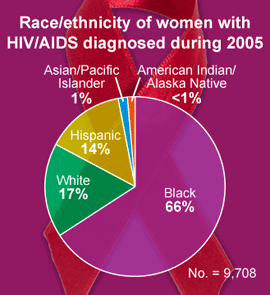Data & Statistics
Featured Data & Statistics

Monday, March 10, 2008 is National Women and Girls HIV/AIDS Awareness Day (NWGHAAD). The HIV/AIDS epidemic is a health crisis for women and girls around the world.
HIV/AIDS in 2005
• Of 40,608 AIDS diagnoses in the 50 states and the District of Columbia, 10,774 (26%) were for women [1].
• The rate of AIDS diagnosis for black women (45.5/100,000 women) was approximately 23 times the rate for white women (2.0/100,000) and 4 times the rate for Hispanic women (11.2/100,000) [1].
• An estimated 95,959 women were living with AIDS, representing 23% of the estimated 421,873 people living with AIDS in the 50 states and the District of Columbia [1].
• An estimated 4,128 women with AIDS died, representing 25% of the 16,316 persons with AIDS who died in the 50 states and the District of Columbia [1].
• From the beginning of the epidemic (1981) through 2005, women accounted for 181,802 diagnoses, a number that represents 19% of the 952,629 AIDS diagnoses in the 50 states and the District of Columbia during this period [1].
• From the beginning of the epidemic through 2005, an estimated 85,844 women with AIDS died, accounting for 16% of the 530,756 persons with AIDS who died in the 50 states and the District of Columbia [1].
• Women with AIDS made up an increasing part of the epidemic. In 1992, women accounted for an estimated 14% of adults and adolescents living with AIDS in the 50 states and the District of Columbia [2]. By the end of 2005, this proportion had grown to 23% [1].
• Data from the 2005 census show that together, black and Hispanic women represent 24% of all US women [3]. However, women in these 2 groups accounted for 82% (8,807/10,774) of the estimated total of AIDS diagnoses for women in 2005 [1].
Data References:
1. CDC. HIV/AIDS Surveillance Report, 2005. Vol. 17. Rev ed. Atlanta: US Department of Health and Human Services, CDC: 2007:1–46. Accessed June 28, 2007.
2. CDC. HIV/AIDS Surveillance Report 1998;10(No. 2): 1–43.Accessed March 1, 2007.
3. CDC. National Center for Health Statistics. Bridged-race vintage 2005 postcensal population estimates for July 1, 2000–July 2005, by year, county, single-year age, bridged-race, Hispanic origin, and sex. Available at
http://www.cdc.gov/nchs/about/major/dvs/popbridge/datadoc.htm#vintage2005. Accessed March 1, 2007.
Data Source: CDC. Fact Sheet: HIV/AIDS among Women. June 2007.
For More Information:
- Women and Girls HIV/AIDS Awareness Day Feature
- CDC HIV/AIDS
CDC's Web site for HIV/AIDS in the United States - FDA Office of Women's Health
Advancing Women's Health Through Science and Information
- CDC National Prevention Information Network (NPIN)*
The US reference, referral, and distribution service for information on HIV/AIDS, sexually transmitted diseases (STDs), and tuberculosis (TB)

CDC Web Topic: HIV/AIDS and Women
Learn about the impact of HIV/AIDS on women and girls.

CDC Fact Sheet: HIV/AIDS among Women
AIDS has become a leading cause of death for women.

National HIV Testing Database*
Find an HIV test site near you from the National HIV Testing Database, a CDC-sponsored service available 24 hours a day.

![]() Podcast from CDC Director Dr. Julie Gerberding on HIV and Women
Podcast from CDC Director Dr. Julie Gerberding on HIV and Women
CDC Director Dr. Julie Gerberding provides information on HIV/AIDS and U.S. women and the importance of testing. Date Released: 6/21/2007 (3:13)
Page last reviewed: March 7, 2008
Page last updated: March 10, 2008
Content source: Division for HIV/AIDS Preventions, National Center for HIV/AIDS, Viral Hepatitis, STD, and TB Prevention
Content owner: National Center for Health Marketing
URL for this page: http://www.cdc.gov/features/dsWomenGirlsHIVAIDS
*Links to non-federal organizations are provided solely as a service to our users. These links do not constitute an endorsement of these organizations or their programs by CDC or the federal government, and none should be inferred. CDC is not responsible for the content of the individual organization Web pages found at these links
